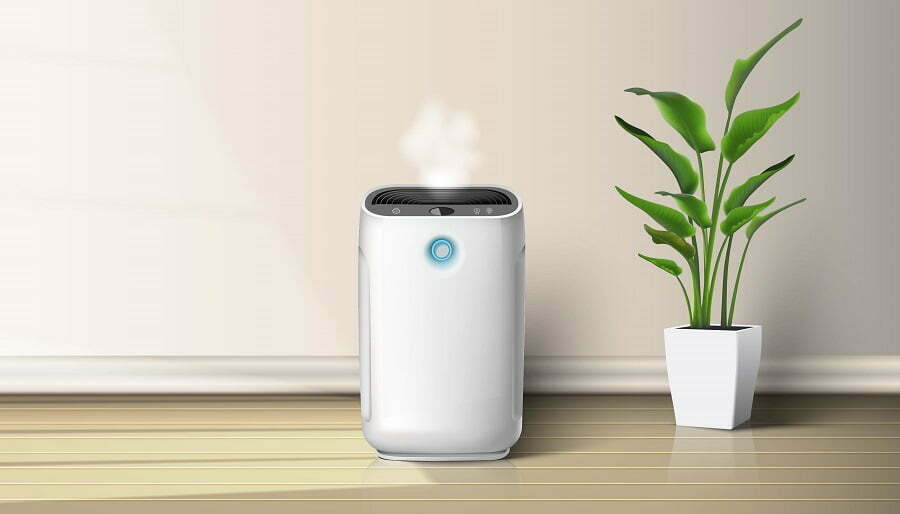Last updated on
Maintaining good air quality in your home is important for your health and well-being. Many people don’t realize how much time they spend indoors, and it’s important to make sure the air you’re breathing is clean.
In this article, we will discuss some tips on how to test and improve the air quality in your home. We’ll also provide some helpful resources that can guide you through the process.
Testing the Air Quality in Your Home

The first step to improving the air quality in your home is to test it. There are many ways to do this, but the most important thing is to get an accurate reading.
The Environmental Protection Agency (EPA) recommends using a professional air quality testing service. This will give you the most accurate results. However, if you’re on a budget, there are some do-it-yourself air quality testing kits available.
There are a few things to keep in mind when you’re testing the air quality in your home. First, make sure you test all the rooms in your house. Second, take multiple readings over a period of time. This will give you a more accurate picture of the air quality in your home.
Finally, if you have any concerns about the results, consult a professional. The most common indoor air pollutants are volatile organic compounds (VOCs), carbon monoxide, dust, and mold. VOCs are gases that are released from certain solids or liquids.
They can come from a variety of sources, including cleaning products, paint, and office equipment. VOCs can cause a variety of health problems, including eye and respiratory irritation, headaches, and dizziness.
Carbon monoxide is a gas that is produced when fuel is burned. It can come from a variety of sources, including furnaces, fireplaces, and cars. Carbon monoxide is dangerous because it is odorless and colorless, so you can’t see or smell it.
If you’re exposed to high levels of carbon monoxide, it can cause serious health problems, including headaches, dizziness, and even death.
Dust is made up of a variety of things, including pollen, pet dander, and dust mites. Dust can cause a variety of health problems, including respiratory irritation and allergies.
Mold is a type of fungus that grows in damp, dark places. Mold can cause a variety of health problems, including respiratory irritation and allergies.
Improving the Air Quality in Your Home

Once you’ve tested the air quality in your home, you can start taking steps to improve it.
One of the best ways to improve the air quality in your home is to ventilate it. This means opening doors and windows to let fresh air in and stale air out.
Another way to improve the air quality in your home is to remove sources of pollution. This might include getting rid of carpets, using natural cleaning products, and avoiding the use of aerosols.
Air Purifier
Another way to improve the air quality in your home is to use an air purifier. Air purifiers work by trapping pollutants in a filter and removing them from the air.
There are a variety of different types of air purifiers on the market, so it’s important to do some research to find one that will work best for your needs. If you have a specific concern, like allergies or asthma, there are air purifiers that are designed to address those needs.
Get Professional Help
If you’re still having trouble improving the air quality in your home, you can get professional help. There are a variety of companies that specialize in air quality testing and improvement.
These companies can help you identify the source of the problem and take steps to improve the air quality in your home.
Ventilation
One of the best ways to improve the air quality in your home is to ventilate it. This means opening doors and windows to let fresh air in and stale air out.
Ventilation is especially important if you live in an area with a lot of smog or pollution. You should also ventilate your home if you’re using products that release VOCs, like cleaning products or paint.
Air Conditioning and Heating
Your air conditioner and furnace can also help improve the air quality in your home. These systems circulate the air in your home and filter out pollutants. Make sure you change the filters on your air conditioner and furnace regularly to ensure they’re working properly.
When you’re using your air conditioner or furnace, make sure you open the vents to allow the air to circulate. It’s also a good idea to keep the doors and windows closed to prevent pollutants from coming into your home.
When choosing an air conditioner or furnace, look for one that has an Energy Star rating. This means it’s more efficient and will use less energy, which is better for the environment.
Dehumidifier
If you live in an area with high humidity, you might want to consider using a dehumidifier. Dehumidifiers work by removing moisture from the air. This can help reduce mold and dust mite growth.
It can also help relieve symptoms of allergies and asthma. This is because high humidity can make these conditions worse.
When it comes to choosing a dehumidifier, there are a few things you need to consider. The first thing to think about is the size of the unit. Dehumidifiers come in a variety of sizes, so you need to choose one that will fit your needs.
You also need to think about the types of pollutants the dehumidifier will be removing from the air. Some dehumidifiers are designed to remove specific types of pollutants, like mold or dust mites.
You also need to think about how often you’ll be using the dehumidifier. If you plan on using it every day, you’ll need one with a larger capacity than if you plan on using it only occasionally.
Another thing to consider is the noise level of the dehumidifier. Some units are louder than others. You also need to think about the price and whether or not the dehumidifier has a filter that needs to be replaced. Some filters need to be replaced every few months, while others can last for up to a year.
Indoor Plants
Indoor plants can also help improve the air quality in your home. Plants help remove pollutants from the air and improve indoor air quality. They also add oxygen to the air and help improve indoor air quality.
When choosing plants for your home, make sure you choose ones that are known to improve air quality. Plants like spider plants, aloe vera, and bamboo are all good options.
When it comes to taking care of plants, there are a few things you need to keep in mind. The first thing to think about is the amount of sunlight the plant needs.
Some plants need direct sunlight, while others can tolerate indirect sunlight. You also need to think about how much water the plant needs.
Some plants need water every day, while others only need water every other day. You also need to think about the type of soil the plant needs. Some plants like sandy soil, while others like clay soil. You can also buy soil specifically for plants.
Another thing to think about is the size of the pot the plant is in. The pot should be big enough so that the plant can grow and spread its roots.
If the pot is too small, the plant will not be able to grow properly. You also need to make sure the pot has drainage holes so that excess water can escape.
Clean and Dust Regularly
One of the simplest ways to improve the air quality in your home is to keep it clean and dust-free. This means vacuuming and dusting on a regular basis.
It’s also important to avoid using products that release VOCs, like cleaning products or aerosols. If you use these products, make sure you open the windows to ventilate your home.
When it comes to cleaning your home, there are a few things you need to keep in mind. The first thing to think about is the type of surface you’re cleaning.
Some surfaces, like wood, can be scratched if you use the wrong type of cleaner. You also need to think about the amount of scrubbing you’ll need to do. Some cleaners require a lot of scrubbing, while others are easy to use and require little effort.
You also need to think about the type of cleaner you’re using. There are a variety of cleaners on the market, including sprays, liquids, and powders. You also need to think about the ingredients in the cleaner.
Some cleaners contain harmful chemicals that can release VOCs into the air. If you’re looking for a safe and effective cleaner, consider using a product that contains vinegar or baking soda. These cleaners are non-toxic and environmentally friendly.
When it comes to cleaning your home, it’s important to work in a well-ventilated area. This will help prevent any harmful chemicals from releasing into the air.
It’s also important to avoid using products that contain ammonia or bleach. These products can cause respiratory problems and should be avoided if possible.
Use Natural Cleaning Products
When you’re cleaning your home, it’s important to use natural cleaning products. This is because many traditional cleaning products release VOCs into the air. These VOCs can contribute to indoor air pollution. There are a variety of natural cleaning products on the market, or you can make your own. Popular natural cleaning products include vinegar, baking soda, and lemon juice.
Avoid Using Chemicals
Whenever possible, you should avoid using chemicals in your home. This includes things like paint, pesticides, and cleaners. If you must use these products, make sure you use them in a well-ventilated area and follow the directions on the label. When you’re finished using the product, make sure you properly dispose of it.
Smoke Outside
If you smoke, it’s important to do it outside. Smoking indoors can significantly increase the level of indoor air pollution. If you live with someone who smokes, ask them to smoke outside.
When you’re smoking, make sure you use a fan to ventilate the area. Smoke from cigarettes, cigars, and pipes can all contain harmful chemicals that can pollute the air in your home.
Be Careful When Using Candles and Incense
Candles and incense can be a great way to make your home smell nice. However, they can also release VOCs into the air. If you use candles or incense, make sure you do so in a well-ventilated area.
You might also want to consider using an essential oil diffuser. These diffusers use essential oils to fragrance the air. They don’t release VOCs into the air, making them a safer option.
Monitor the Air Quality in Your Home
There are a variety of air quality monitors on the market that can help you monitor the air quality in your home. These monitors will test the air for various pollutants and give you a reading. This can help you identify areas where the air quality is poor and take steps to improve it.
When choosing an air quality monitor, make sure you choose one that tests for a variety of pollutants. Look for a monitor that tests for things like carbon monoxide, VOCs, and particulate matter. It’s also important to choose a monitor that is easy to use.
You should be able to understand the readings and take action if necessary. It’s also important to choose a monitor that is durable and can withstand being used in a variety of environments.
In conclusion, there are a number of things you can do to improve the air quality in your home. These include using natural cleaning products, avoiding chemicals, and smoking outside.
You should also monitor the air quality in your home and take steps to improve it if necessary. By following these tips, you can help ensure that the air in your home is clean and safe to breathe. With so many benefits, there’s no reason not to take action.
Recap:



